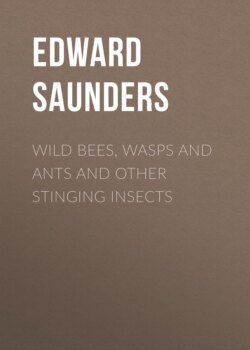Читать книгу Wild Bees, Wasps and Ants and Other Stinging Insects - Edward Saunders - Страница 6
На сайте Литреса книга снята с продажи.
DESCRIPTION OF THE COLOURED PLATES
ОглавлениеTable of Contents
PLATE A
Figs. 1, 2, 3. Formica sanguinea Latr.: male, female, and worker. The host of Lomechusa (p. 89), also a slave-making species; makes irregular nests of dead leaves, etc., generally against a sloping bank.
Figs. 4, 5. Mutilla europæa Linn.: male and female. One of the few British species of Aculeates where the female is wingless; found in sandy places running in the sun.
Fig. 6. Cerceris arenaria L.: female; burrows in the sand, and provisions its nest with beetles (p. 20).
Fig. 7. Ammophila sabulosa L.: female; burrows in the sand, provisions its nest with caterpillars, peculiar for its very elongated waist (p. 22).
Fig. 8. Crabro cribrarius L.: male; peculiar for its paddle-like tibiæ and flattened antennæ (p. 103).
Fig. 9. Odynerus spinipes L.: male; peculiar for the form of its middle femora, which are cut out almost in two semicircles (p. 101); female makes a tubular entrance to her nest (p. 25).
PLATE B
Fig. 10.—Colletes succinctus L.: female; lines its cells with a gluey material (p. 44); colonizes in sandy banks; host of Epeolus rufipes (fig. 19).
Fig. 11. Sphecodes subquadratus Smith: female; cuckoo of a species of Halictus; female hibernates like its host (p. 17).
Fig. 12. Halictus lencozonius Schr.: burrows in the ground; the host of Sphecodes pilifrons Thoms (p. 17).
Fig. 13. Vespa crabro L.: female (the Hornet), nests in hollow trees; host of the rare beetle Velleius dilatatus (p. 38).
Fig. 14. Vespa vulgaris L.: female: one of our commonest wasps; nests usually in the ground (p. 35); host of a peculiar beetle (Metœcus paradoxus) (p. 38)
Figs. 15, 16. Andrena fulva Schr.: male and female; the bee which burrows in lawns, etc. (p. 9); host of Nomada ruficornis var. signata (p. 15).
Fig. 17. Panurgus ursinus Gmel.: Female; legs loaded with pollen, burrows in hard sandy paths, etc. (p. 49). Males sleep curled up amongst the rays of yellow composite flowers.
Fig. 18. Nomada ruficornis L. var. signata: cuckoo of Andrena fulva (figs. 15 and 16).
Fig. 19. Epeolus rufipes Thoms: female; cuckoo of Colletes succinctus (fig. 10).
PLATE C
Fig. 20.—Megachile maritima Kirby: female; burrows in the ground, makes its cells of pieces of leaves, which it cuts out with its mandibles; host of Cœlioxys conoidea.
Figs. 21, 22. Cœlioxys conoidea Illig: male and female; cuckoo of Megachile maritima.
Fig. 23. Burrows of Megachile Willughbiella Kirby, in a piece of rotten willow; each burrow originally contained six cells, but two of the left-hand series have been lost.
PLATE D
Figs. 24 and 25. Anthophora pilipes F.: male and female. A spring bee, the male of which may often be seen in gardens, darting from flower to flower (p. 81); while the female collects pollen; it forms large colonies (p. 62).
Fig. 26. Melecta armata Pz.: cuckoo of Anthophora pilipes.
Fig. 27. Anthidium manicatum L.: invests its cells with the down off the stems of labiate plants, which it strips off with its mandibles (p. 50).
Fig. 28. Osmia bicolor Schr.: female; nests in snail-shells, which it sometimes covers up with small pieces of grass-stems till a little mound is formed, resembling a diminutive ants' nest (p. 59).
Fig. 29. Bombus terrestris L.: female. One of the commonest of our Humble Bees; it nests in the ground. It is the host of Psithyrus vestalis, which resembles it very closely in colour; it is this species that was exhibited by Mr. Sladen at the Maidstone Agricultural Hall (p. 41).
Fig. 30. Bombus lapidarius L.: another common Humble Bee, also an underground builder; it is the host of Psithyrus rupestris.
Fig. 31. Psithyrus rupestris F.: female; the cuckoo of Bombus lapidarius, which it closely resembles except for the nearly black colour of the wings.
